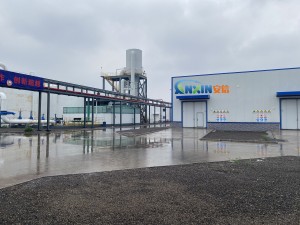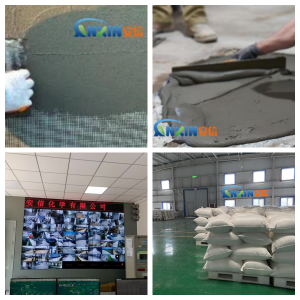Hydroxypropyl methylcellulose (HPMC) is a commonly used nonionic cellulose ether that plays a vital role in building materials. Its excellent thickening, water-retention, film-forming, and lubricating properties make it an indispensable functional additive in building systems such as dry-mix mortar, tile adhesives, putty powder, gypsum products, and thermal insulation mortars. Appropriate application of HPMC not only improves workability but also significantly enhances the material’s adhesion, water retention, and durability.
1. HPMC’s primary role in building materials is reflected in the following aspects:
Water-retention: HPMC molecules contain numerous hydrophilic hydroxyl and methoxy groups, which form stable hydrogen bonds with water, effectively slowing evaporation. Adding an appropriate amount of HPMC to cement mortar prevents premature water loss, enhances hydration, and improves the mortar’s workability and strength development. This is particularly important for materials applied in high-temperature or dry environments.
Thickening and rheology control: HPMC increases system viscosity, imparting excellent thixotropy and flowability to the mortar. It prevents mortar delamination and bleeding, improving application stability. Especially in tile adhesives and putties, HPMC with the right viscosity imparts excellent anti-slip properties, facilitating application.
Improving Adhesion: HPMC exhibits excellent film-forming properties, forming a uniform polymer film on the substrate surface, strengthening the interfacial bond between the cement slurry and the base or tile. Its surface activity also improves substrate wettability, enhancing the overall bond strength of the material.
Improving Workability: During plastering, scraping, or spraying, HPMC provides moderate lubrication, reducing friction between tools and materials, making application easier and smoother.
Delaying Setting Time: HPMC adsorbs on the surface of cement particles, slowing ion diffusion and thus slowing setting, providing workers with a longer working time.
2. To fully utilize the performance of HPMC, its application in building materials requires scientific optimization:
Selecting the appropriate viscosity and degree of substitution: HPMC’s viscosity and degree of substitution directly influence its water retention and rheological properties. Generally speaking, low-viscosity HPMC has good fluidity and is suitable for spraying or leveling systems. Medium- and high-viscosity products offer enhanced water retention and are suitable for systems requiring high water retention, such as tile adhesives and thermal insulation mortars. By choosing HPMC with different viscosity grades, a balance can be achieved between fluidity and adhesion.
Optimizing dosage control: Too low an HPMC dosage will not fully achieve its water-retention effect, while too high an amount may result in excessive viscosity and construction difficulties. The typical dosage in building mortars is 0.1% to 0.5% of the cementitious material by weight, with the specific dosage adjusted based on the formulation and climatic conditions.
Combined use with other additives: HPMC is often used in combination with starch ethers and redispersible polymer powders (RDP). Starch ethers improve application feel and anti-slip properties, while RDP enhances flexibility and bond strength. Together, these three significantly optimize the overall performance of the mortar system.
Focus on dissolution and dispersion techniques: The dispersibility of HPMC directly impacts the final result. A dry-mix dispersion method should be used: HPMC should be thoroughly mixed with other powders before adding water and stirring to prevent clumping and ensure uniform performance.
Adjust the formulation based on the climate: In hot or dry areas, high-viscosity HPMC with enhanced water retention should be used; in cold and humid regions, low-viscosity products can be selected to ensure fluidity and application efficiency.
HPMC is not only a thickener in building materials but also a key functional component that influences application performance and final quality. By selecting the right type, controlling the dosage, and optimizing it in combination with other additives, the stability, adhesion, and application experience of the mortar system can be significantly improved. In the future, with the increasing demand for energy-saving and green construction, high-performance, low-residue, and easily dispersible HPMC will become a key development direction for building additives.
Post time: Oct-09-2025








